Louis Auguste de Sainson
France, b.1800, d.1874
Nouvelle-Zélande
- c. 1833
- Hand coloured lithograph
- Purchased 2010
- 517 x 340mm
- 2011/011
Tags: cloaks, feather (material), hair, koru (pattern), Māori (culture or style), moko, people (agents), profiles (figures), spirals (geometric figures), tattoos

Related reading: Ka Honoka
Notes
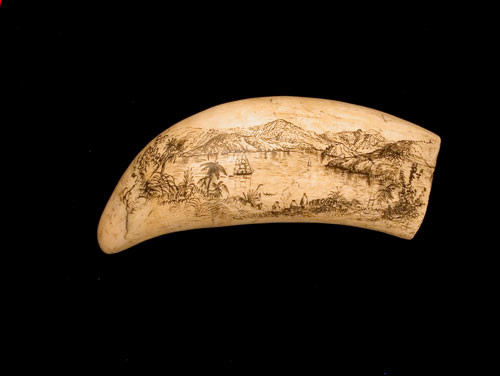
Happy Birthday Akaroa Museum
Big Congratulations to Akaroa Museum on their 50th anniversary which they are celebrating this weekend.
Article
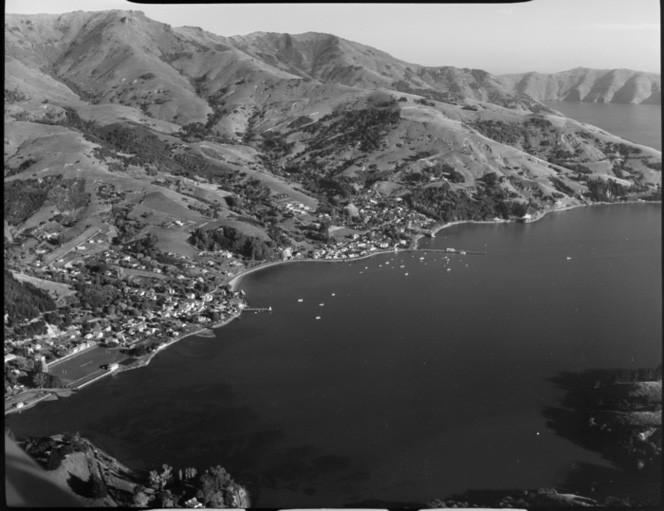
A Tale of Two Chiefs
If you have recently visited He Taonga Rangatira: Noble Treasures at the Gallery you will have been struck by Fiona Pardington's two large photographic portraits of lifelike busts of Ngāi tahu tipuna (ancestors).
Collection
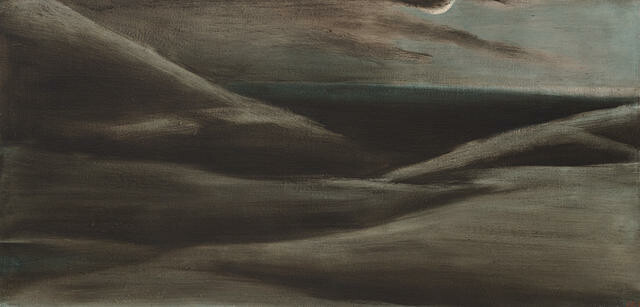
Tony Fomison Night time, Amuri Bluff
“I came from the South Island, and the South Island I must mention! Yes your mountains still pile up in my thoughts! Your shorelines still run round the edges of the same. Big canoe of Maui, my little paddle will always be at your side.” —Tony Fomison, 1979 Te Waipounamu South Island always loomed large in Tony Fomison’s psyche, even after he made the shift north to Tāmaki Makaurau Auckland from his hometown of Ōtautahi Christchurch in 1973. Drawn from memory and past experiences, the Waitaha Canterbury landscape continued as the subject of many of his paintings, including ‘Night Time, Amuri Bluff’. Fomison had developed a strong sense of the history of the land through his work as an assistant archaeologist for Canterbury Museum, where he researched early Māori settlements and whaling stations near Kaikōura and Horomaka Banks Peninsula – including the Māori settlement site Haumuri, also known as Amuri Bluff, on the Kaikōura coastline.
(He Kapuka Oneone – A Handful of Soil, 2025)
Collection
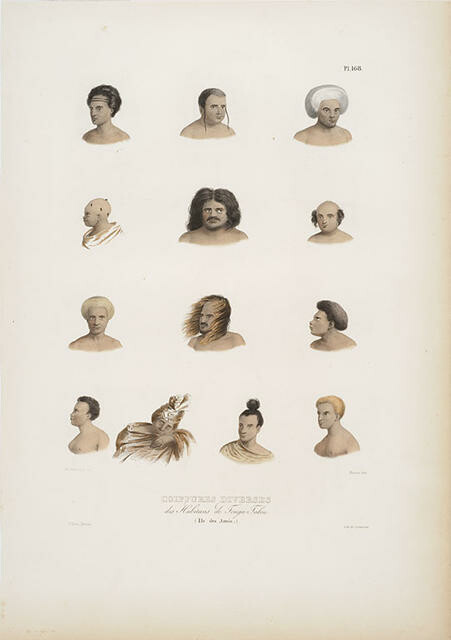
Louis Auguste de Sainson Coiffures diverses des habitans de Tonga Tabou, lle des Amis
Louis Auguste de Sainson was the official artist aboard Captain Dumont d’Urville’s Astrolabe. He spent three months in New Zealand in 1827 on a maritime mapping survey between Tasman Bay and the Bay of Islands, followed by a month in Tonga. A substantial publication on d’Urville’s 1826–29 voyages through Asia and the Pacific was published in Paris in 1833, profusely illustrated by lithographic prints after de Sainson’s drawings.
D’Urville and his crew had close contact with people they met, including the Totaranui chief Tehinui (or Tehi-Noui) and his travelling companion Kokiore (or Koki-Hore) depicted in print 2, who were sketched by de Sainson after coming aboard at Palliser Bay (near present-day Wellington). Tehinui and Kokiore at first both intended to reach Europe, but instead disembarked at Tolaga Bay, later finding their own way home. In summarising his portrait sketching process, de Sainson later recalled: “What I was doing caused a lot of laughter; every minute they tried to escape me.” (Kā Honoka, 18 December 2015 – 28 August 2016)
Collection
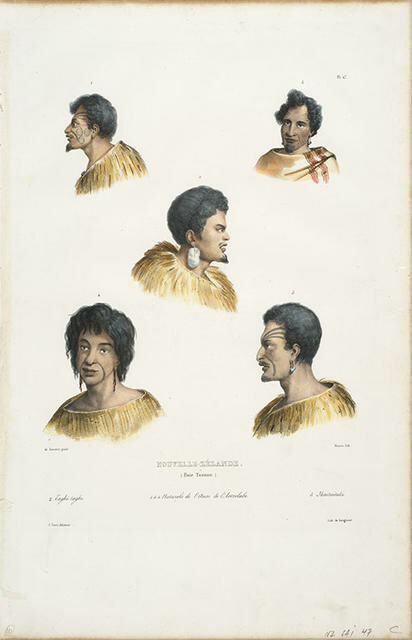
Louis Auguste de Sainson Nouvelle-Zélande
Louis Auguste de Sainson was the official artist aboard Captain Dumont d’Urville’s Astrolabe. He spent three months in New Zealand in 1827 on a maritime mapping survey between Tasman Bay and the Bay of Islands, followed by a month in Tonga. A substantial publication on d’Urville’s 1826–29 voyages through Asia and the Pacific was published in Paris in 1833, profusely illustrated by lithographic prints after de Sainson’s drawings.
D’Urville and his crew had close contact with people they met, including the Totaranui chief Tehinui (or Tehi-Noui) and his travelling companion Kokiore (or Koki-Hore) depicted in print 2, who were sketched by de Sainson after coming aboard at Palliser Bay (near present-day Wellington). Tehinui and Kokiore at first both intended to reach Europe, but instead disembarked at Tolaga Bay, later finding their own way home. In summarising his portrait sketching process, de Sainson later recalled: “What I was doing caused a lot of laughter; every minute they tried to escape me.” (Kā Honoka, 18 December 2015 – 28 August 2016)
Collection
![Nouvelle-Zélande - coffre en bois sculpté [Plate 59]](/media/cache/d2/0d/d20d3e71824f4f302a9ddce9f4f594ca.jpg)
Louis Auguste de Sainson Nouvelle-Zélande - coffre en bois sculpté [Plate 59]
Louis Auguste de Sainson was the official artist aboard Captain Dumont d’Urville’s Astrolabe. He spent three months in New Zealand in 1827 on a maritime mapping survey between Tasman Bay and the Bay of Islands, followed by a month in Tonga. A substantial publication on d’Urville’s 1826–29 voyages through Asia and the Pacific was published in Paris in 1833, profusely illustrated by lithographic prints after de Sainson’s drawings.
D’Urville and his crew had close contact with people they met, including the Totaranui chief Tehinui (or Tehi-Noui) and his travelling companion Kokiore (or Koki-Hore) depicted in print 2, who were sketched by de Sainson after coming aboard at Palliser Bay (near present-day Wellington). Tehinui and Kokiore at first both intended to reach Europe, but instead disembarked at Tolaga Bay, later finding their own way home. In summarising his portrait sketching process, de Sainson later recalled: “What I was doing caused a lot of laughter; every minute they tried to escape me.” (Kā Honoka, 18 December 2015 – 28 August 2016)
Collection
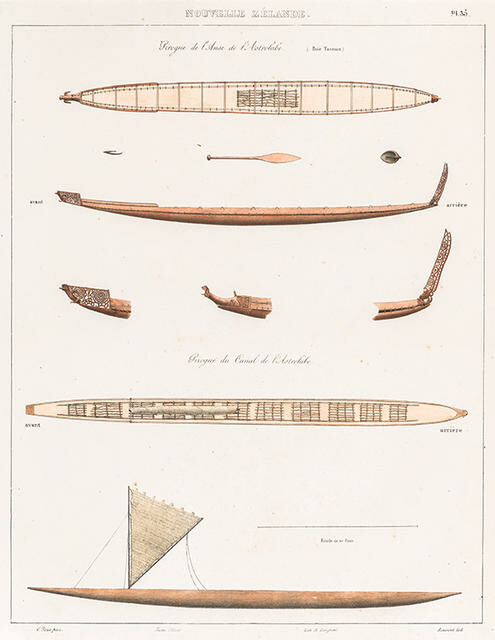
François-Edmond Pâris, Pierre Langlumé, Jean-Antoine Laurent, Joseph Tastu Nouvelle Zélande. Pirogue de L'Anse de l'Astrolabe. (Baie Tasman.), Pirogue du Canal de l'Astrolabe. Pl. 35
Aged just twenty when he joined Dumont d’Urville’s 1826–29 Pacific survey, François-Edmond Pâris created a comprehensive visual record of ships and boats encountered. In 1827 he recorded vessels he saw at Ūawa Tolaga Bay and Paepae-o-Tū Bream Bay, and Te Tai-o-Aorere Tasman Bay and Tāmaki Strait, Auckland.
(Out of Time, 23 September 2023 – 28 April 2024)
Collection
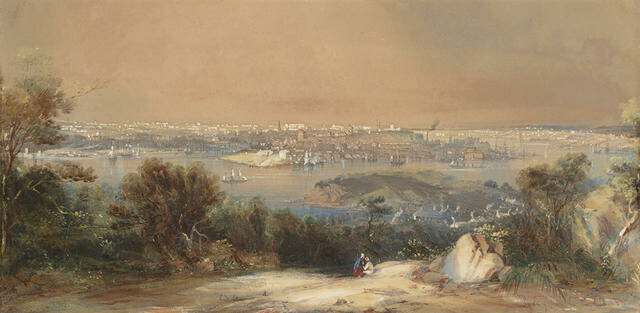
Conrad Martens Sydney from the North Shore
Conrad Martens left England for Rio de Janeiro in 1833. By December had reached Montevideo, Uruguay, where he joined Captain FitzRoy and Charles Darwin on the HMS Beagle, becoming ship’s artist on a survey of South American coasts. In 1835, Martens settled in Sydney and became an admired landscape painter who also produced popular hand-coloured lithographs.
(Out of Time, 23 September 2023 – 28 April 2024)